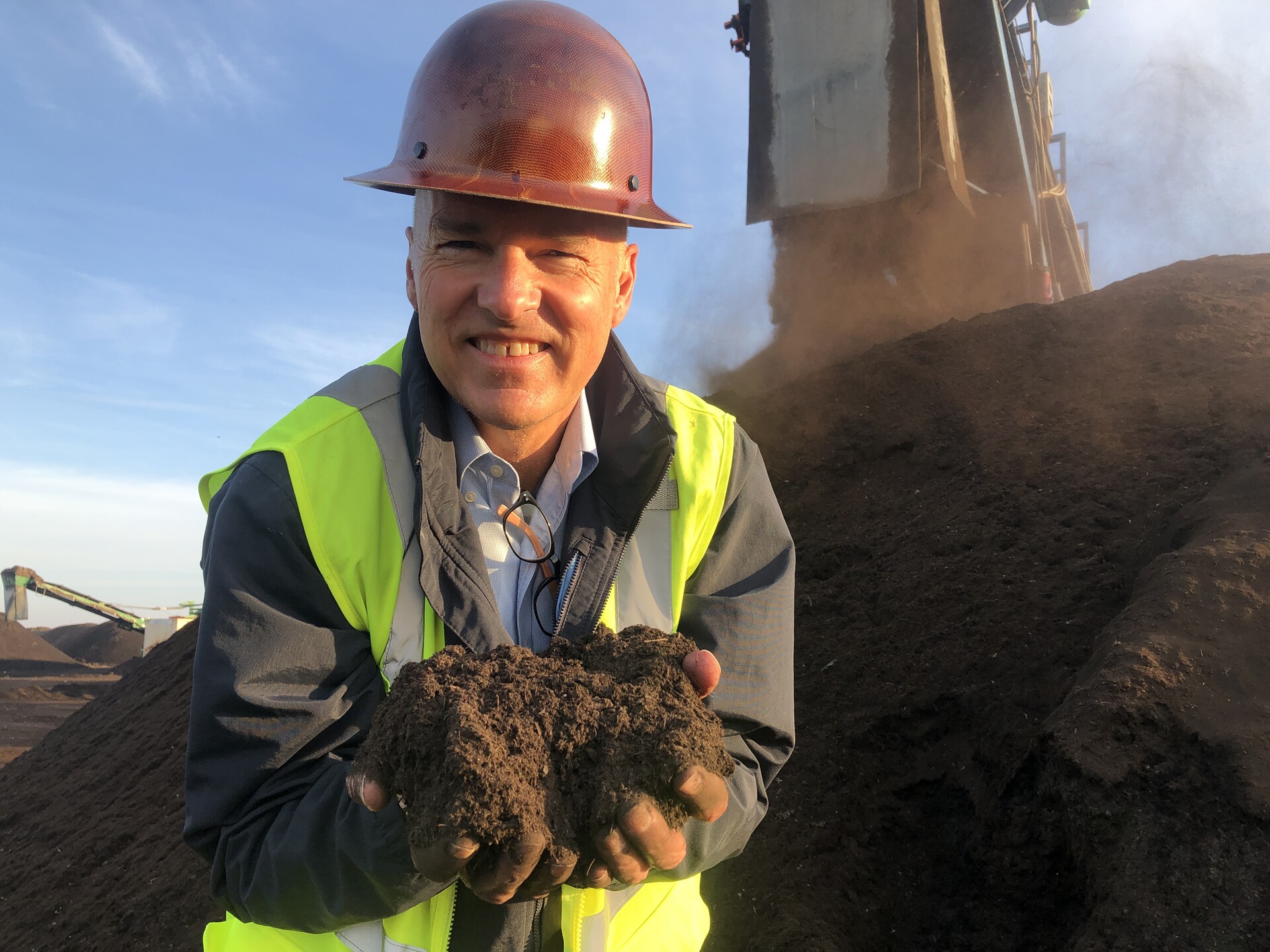Municipal solid waste landfills are the third-largest source of human-related methane emissions in the country, accounting for about 15% in 2019, according to the Environmental Protection Agency.
Scientists and engineers see an opportunity to capture methane and use it to create energy. They’re also studying how it can lock carbon in the ground and enhance the soil in fields, orchards and rangelands to help farmers grow crops and livestock more efficiently.
One challenge for the state: building enough facilities like Recology’s, especially in Southern California, where composting is less common. Commercial-scale manufacturing businesses are expensive, and require land and heavy machinery.
 Robert Reed, compost hype man, in Tracy on Jan. 31, 2022. ‘This is what helps grow healthy plants,’ Reed said. (Raquel Maria Dillon/KQED)
Robert Reed, compost hype man, in Tracy on Jan. 31, 2022. ‘This is what helps grow healthy plants,’ Reed said. (Raquel Maria Dillon/KQED)
Recology began composting decades ago, and Reed argues it keeps greenhouse gasses out of the atmosphere.
“This is what helps grow healthy plants,” he said, plunging his hands into a steaming pile. “We’ve got food to eat and it gets carbon back into the soil where it belongs.”
At this stage, the compost is sorted and dried to a fine dust; it has a rich brown color and smells sweet, like a wet forest floor. But it’s not fully cooked yet. It will sit in windrows, long piles that workers will aerate for weeks while bacteria break the “material down into finished compost,” Reed said.
“These piles are eight- to 10-feet tall and chock-full of microbial colonies that are breaking the material down into smaller and smaller pieces,” he said.
Sprinklers add water to make a perfect, spa-like environment for the right microbes.
New compost rules ‘biggest change’ to CA trash since ’80s
The bacteria are key to the state’s new composting standards, which require all municipalities to collect green waste separately, to keep it out of the landfill. When food waste “cooks” under the right conditions, the bacteria give off less methane, a potent greenhouse gas.
“Diverting our organic waste is the single fastest and easiest thing that every single Californian and every American can do to fight climate change,” said Rachel Machi Wagoner, CalRecycle’s director.
She called the state’s composting mandate “the biggest change to our trash since we started recycling in the 1980s.”
The state will require businesses to compost and donate edible food to food banks and charities. First, large grocery stores and food wholesalers will have to comply or face fines. Later, that list will include restaurants and cafeterias.
If California hits its composting goal, the state estimates it would be the equivalent of taking 1 million cars off the road each year in greenhouse gas emissions reductions.
“To go after food waste that aggressively is unprecedented, and it’s a big deal,” said Matthew Cotton, an independent commercial composting consultant. “We have a lot of infrastructure, maybe not enough.”
The cost of this new infrastructure will be offset by a $90 million infusion from this year’s state budget. But Cotton said it’s hard to get permits for composting at this scale.
“It’s not a popular piece of infrastructure,” he said. “No one says, ‘Hey, let’s put in a composting site.’ It serves a lot of people, but nobody really wants to live by it.”
Getting past the ‘yuck factor’
The other big hurdle is getting people to sort their food waste correctly.
“There’s a big yuck factor,” said Sally Brown, a soil scientist at the University of Washington. “The slimy stuff is slimy and it can smell bad and look gross and then you don’t want to touch it.”
Composting can be a hard sell, when you’ve been throwing stuff away your whole life, Brown said.
There’ll always be a market for high-quality compost, especially in California, where agriculture is such a big business, she said. But if the final compost product is contaminated, it becomes less desirable to farmers and landscapers. Think plastic bags, rocks and those annoying little stickers on fruits and veggies.
“The top lid on your Häagen-Dazs container — it feels like cardboard, but is that plastic on the edge?” she said, noting that many people might not care enough to investigate.
California’s golden age of compost
California is in a golden age of compost research and policy, Brown said. Farmers have always known that compost adds nutrients to their fields and orchards. Now scientists are trying to measure how much carbon it locks into soil and how that benefits the climate.
“I had 16-inch carrots in my garden this year, and that’s because of the healthier, lighter and fluffier soil from years of compost use,” she said.
“It doesn’t require genius cold-fusion tech. It requires you to put your broccoli stems into a different bucket. We can handle that — in theory,” Brown said.




















